This unsuspecting building on the high street is an architectural gem from of its era.

To accommodate the erection of this entertainment complex a hotel on the site was demolished to make way for the cinema. A request for a license is believed to have been made to the Local Authority as early as 1907. The Auditorium or hall was built first, sometime between 1907 and 1910 as the Paignton Bioscopic Exhibition centre.
The Paignton Picture House opened on 16th March 1914 and was designed by local architects Hyams & Hobgen the free Baroque style with the added addition of the increasingly popular Art Nouveau decorative details. A fine example of which, is the doorway to lower foyer in the form of a round-headed varnished timber architrave with triple egg moulding housing panes of bevelled glass. The vibrant stained glass in the design of foliage and fruit of the same style adds not only colour but also sophistication to the first-floor landing.
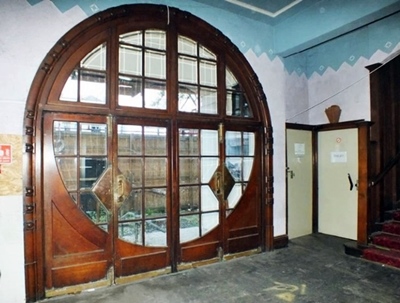
The beautiful solid wood and bevelled glass entrance door adds a sophistication from the art nouveau era.
The exterior of the building is in a Classical style with a pediment arch over a centrally placed bow window which is set in a recess. It was soon hailed as one of the most important
To accommodate the erection of this entertainment complex a hotel on the site was demolished to make way for the cinema. A request for a license is believed to have been made to the Local Authority as early as 1907. The Auditorium or hall was built first, sometime between 1907 and 1910 as the Paignton Bioscopic Exhibition centre.
The Paignton Picture House opened on 16th March 1914 and was designed by local architects Hyams & Hobgen the free Baroque style with the added addition of the increasingly popular Art Nouveau decorative details. A fine example of which, is the doorway to lower foyer in the form of a round-headed varnished timber architrave with triple egg moulding housing panes of bevelled glass. The vibrant stained glass in the design of foliage and fruit of the same style adds not only colour but also sophistication to the first-floor landing.
The exterior of the building is in a Classical style with a pediment arch over a centrally placed bow window which is set in a recess. It was soon hailed as one of the most important purpose-built original cinemas in the country and built on the back of what was then the Broadmead Hotel in Torbay Road right next to the railway.
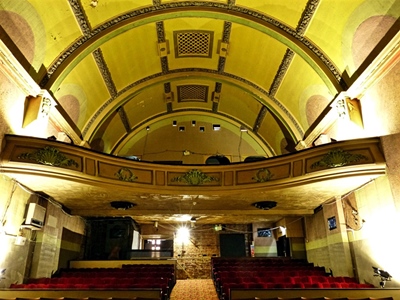
View of the sweeping curved balcony and barrelled ceiling provide elegance and grandeur to the auditorium.
Inside, the Auditorium has a 6-bay barrel ceiling with ribs supported on corbels decorated with relief heads of Mary Pickford and that of her male counterpart wearing the headdress of Moses, being either her husband Douglas Fairbanks who in 1919 with their friends Chaplin and D.W. Griffith formed United Artists, forming the film company to maintain artistic control, to control distribution and to control profits from their films. Fairbanks, Pickford and Chaplin established the Motion Picture Fund to help those in the industry who could not work or were unable to meet their bills. The couple married in 1922 honeymooned in Europe and everywhere they went they were greeted by massive crowds. They had become the first celebrity couple. This could alternatively be her stepson Douglas Fairbanks Junior who also later became a large global movie star. The movie star reliefs were added at a later date.
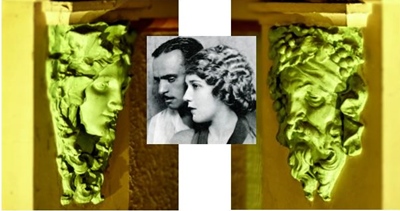
Is this the face of Douglas Fairbanks or his son by his first wife, Douglas Fairbanks Jr?
The ceiling is tastefully decorated with relief mouldings of fruit and foliage. The wall lights are perfect examples the Art Deco style from the 1930s era and show the craftsmanship of local smith. The ice cream sundae pastel colours on the wall and ceiling have remained unchanged over the years since the doors opened to it patrons and provide a light and airy atmosphere. Another delightful, unmistakeable elegant feature of the Auditorium is the curved balcony.

Original Art Deco lights exude glamour.
Housing 375 tip up seats comfortably seats: 271 in the stalls, 104 in the circle, plus three private boxes at the back seating an additional eight located at the rear of the circle. During its early days it featured a 21-piece orchestra, with each member paid a guinea to perform.
Later, it was known as Paignton Electric Picture Palace and then as the Paignton Picture House after the company who then ran the cinema and a film library, hiring out film to other organizations, that was incorporated on 15 April 1913.
In 1933 some modernisation was done to the Auditorium and the seating capacity raised to 600. This modernisation appears to be have been of minimal impact on the original decoration of the building retaining almost all its original features.
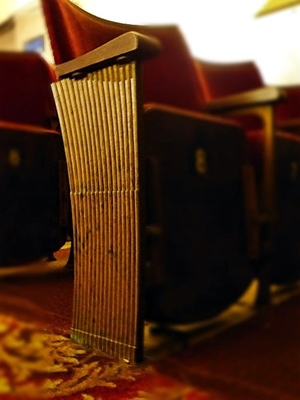
Art deco carved end seat panels imitate reeds with stylish flair.
Circa 1947 it became known as the Picture House and continued as an independently operated cinema, re-named the Torbay Cinema in 1968.
On 20th February 1991 this glamorous building became a grade II listed building having been taken over by the adjacent Dart Valley Railway company in 1987 with the view to convert the Torbay Cinema to enhance the ‘period’ experience of having an Edwardian cinema next to the historic steam railway used as a booking hall, but this use has been blocked by preservationists and locals who would rather it be used to screen movies (perhaps transport films depicting the age of steam railways) would be a better option than exists at present with the building sitting empty and unused.
Sadly, this beautiful art deco cinema closed its doors on 26th September 1999 with a special showing of Bill Travers in “The Smallest Show on Earth” plus a variety show on the small stage. Its demise was caused by the opening of the nine-screen Apollo multiplex in Paignton.
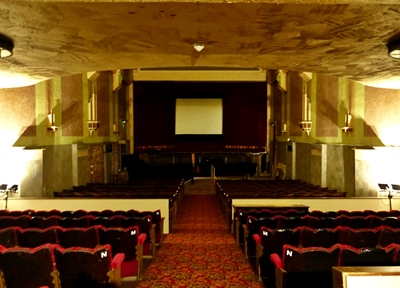
View of the screen and orchestra pit as seen from the entrance, below the circle seats above.
Many people have very fond and happy memories of time spent within its wall, times of happiness, laughter and sadness. For many years, its most famous patron, the authoress Agatha Christie who loved it so much shared her passion with her family for many years visiting the Picture House whilst she lived in Dartmouth. She used to sit in row two, seat 2 in the circle. In her books, the ‘Gaiety Cinema’ is a loving tribute to Torbay Picture House. Peter Cook, and it is believed that Edward and Mrs. Simpson had also visited and well-known resident Paris Singer with the famous dancer Isadora Duncan at his side. Singer also sold a grand piano to the cinema company. Most recently, HRH the Earl of Wessex.

HRH the Earl of Wessex chats with local school children during his visit 3rd May 2017.
This precious gem is now one of the oldest surviving, purpose-built cinemas in Europe and with the formation of The Paignton Picture House Trust in November 2013 to aid the continuance of this structure’s viable future with the assistance of a £40,000 grant from Historic England and additional funding from Torbay Council, completed the purchase of the cinema in November 2015. This will hopefully secure the continued use by the people of Torbay for whom it was constructed.
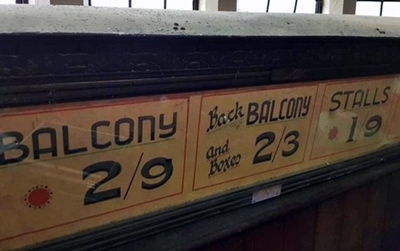
The original price box would have been lit up and hung outside.
Now an independent building preservation trust with an ambitious £2million five year restoration plan which will see the building used for much more than just showing classic and vintage films but for uses as education and arts centre to social events to weddings, and the CTA has grant- aided a business plan and other 'seed-funding' projects as well as the support of its trustees, volunteers alongside local residents and business people such as international photographer Paul Ryan-Goff, and PES Electrical. The Trust has also received an award of £50,000 from the Coastal Revival Fund to carry out essential works to enable progress towards full restoration for which a bid will be made to the Heritage Lottery.
This quote from the Paignton Picture House website sums up this delightful time capsule future “this treasured property still has the possibility to forge a place in Paignton’s future with the help and open its door once again offering pleasure and delight to the local community it once graciously served.”
The Paignton Picture House Trust can be followed on Facebook and via their web site at www.paigntonpicturehouse.org
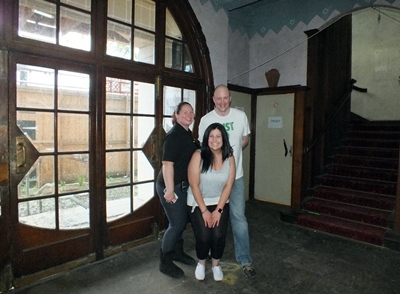
Three of the investigators tour the premises, left: Kelly, Christina, and Andrew.
References:
http://cinematreasures.org/theaters/22124
http://www.creativetorbay.com/networks/creative-torbay/documents/paignton-cinema-pdf.pdf
https://historicengland.org.uk/listing/the-list/list-entry/1208209

